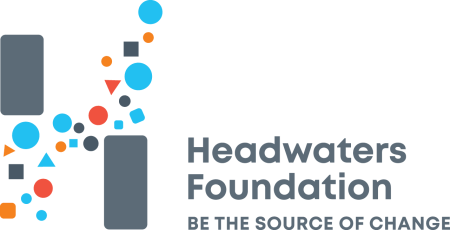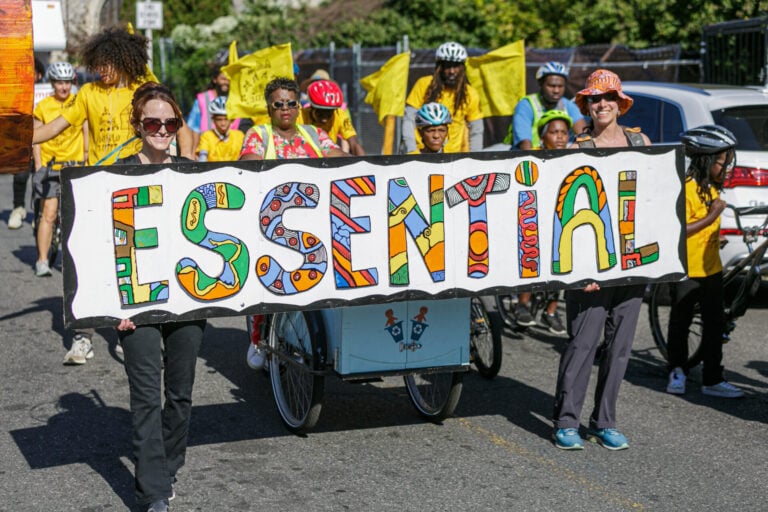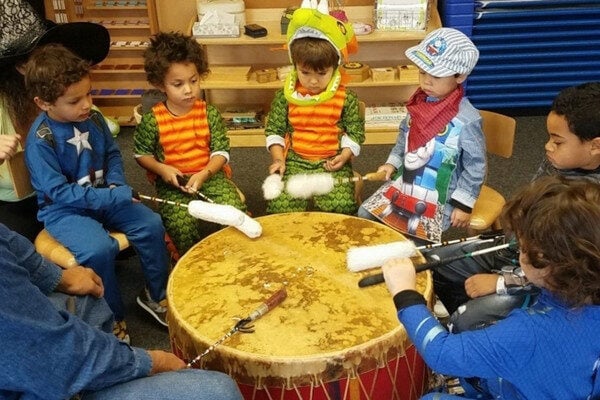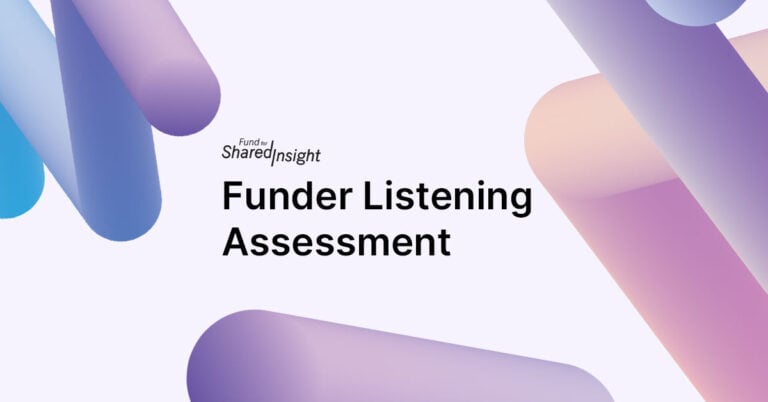Tools & Resources to Shift Power to Communities
Browse Menu
Looking at your role/function within your foundation.
What are listening practices that can shift power?
Assess how you are listening through a set of reflection questions.
Engaging in other large-scale listening activities
For funders committed to shifting power to, and sharing power with, those most impacted by their work, participation is key. Participatory approaches in philanthropy center the leadership, wisdom, and voices of communities. They shift power from philanthropy’s traditional power centers (i.e., the donors and institutions that control the money) to the people and communities directly affected by the issues being addressed.
Resources to shift power
- Rick Moyers
- Fund for Shared Insight
- Fund for Shared Insight
- Fund for Shared INsight
- Fund for Shared Insight
Get inspired by what other funders are working on

The Tepper Foundation supports grantees to work with Listen4Good to build their feedback capacity. The foundation will use the aggregate feedback data from the Listen4Good grantees, which represent a subset of grantees in its Food, Housing and Health portfolio, to identify and respond to shared needs and gaps in services.
A regional family foundation in Arizona engaged Listen4Good to both build nonprofit family resource centers’ capacity across the state to listen systematically to the communities they serve and to share aggregate findings with the local ecosystem. Each center gathers feedback about their clients’ experiences with their services and uses that data to improve programming. The primary funder of family resource centers, a statewide early childhood agency, First Things First, uses the aggregate data from families surveyed to inform its own programmatic strategy and to work with system partners to garner more support for family resource centers across the state. The funding community also benefits from the aggregate data, learning how different segments of the community are served by the centers statewide.
Read more about how funders can listen alongside nonprofits →
As part of its strategy refresh, Headwaters Foundation set out to hear directly from Western Montanans who face the greatest barriers to health. Partnering with a consulting firm, the foundation held five focus groups with “priority populations,” including rural and low-income families, single parents, Spanish-speakers, Indigenous women, and LGBTQ+ residents.
The conversations revealed that the most pressing barriers to health, wellbeing and civic engagement stemmed from struggles to meet basic needs – such as access to healthy food and affordable, quality child care – along with challenges navigating public services due to stigma, lack of information, poor customer service, and experiences of racism.
“We learned so much by listening directly to people with lived experience, without filtering their voices through nonprofit leaders or our own assumptions,” said Erin Switalski, Program Director at Headwaters. “We see ourselves as a systems-change funder, but we kept hearing that people needed their basic needs met before they could participate in that work.”
In response, Headwaters’ new strategy deepens investment in direct services while pairing it with support for policy, advocacy, and local leadership development—a combination that already reflects how many nonprofits, especially in small communities, operate out of necessity. These learnings also led to an increased focus on supporting nonprofits whose boards and staff include members of the very communities most impacted by health inequities.
Building on these insights, the following year Headwaters commissioned and released Supporting Our Neighbors: Understanding Who Uses Public Assistance in Montana, for How Long, and Why. This research aimed to shed light on public assistance programs and address the stigma and misinformation that surfaced in the focus groups, further informing the foundation’s approach to tackling systemic barriers.

When the William Penn Foundation began its most recent strategic planning process, which it undertakes about every ten years, it started with a survey of more than 400 grantees and an additional 200 “grass tops” interviews with grantee and community leaders about the funder’s past grantmaking. To explore future areas of grantmaking focus, the foundation spoke with 116 community and organizational leaders, advocates, and researchers. Later, to market test the outlines of a plan that was starting to emerge against the priorities of the community, the foundation worked with consultants to have 254 additional conversations with community members, nonprofit and government staff, and researchers. At multiple stages, the foundation made sure to include people and organizations who weren’t coming to them with grant requests. William Penn posted program-specific summaries of the feedback on its website, and when the final strategic plan was ready in the summer of 2024, it hosted four briefings in neighborhoods around Philadelphia and online — attended by more than 1,000 people — sharing how community input had helped shape its decisions and inviting additional feedback and questions.


While overall less than one-quarter of the number of grants from U.S. foundations for global efforts go directly to organizations with headquarters in the countries where the work is done, nearly all of Segal Family Foundation’s grantee partners are African-led, and all of the foundation’s program officers are based in the countries where they are making grants. Additionally, a board comprised mostly of representatives from former in-country grantees advises the foundation’s governing board.
“Communities that we serve are at the forefront,” says Sharonrose Msaki, a Segal Family Foundation senior program officer based in Tanzania. “They’re leading, their voices matter.”
She says she and her colleagues listen in formal and informal ways, including through regular conversations with grantees and community members in their primary language when possible. She notes that frequent interaction is key to relationship building and to gaining insights into the context and background of a community.
Such conversations led the foundation to adjust a grantmaking rule limiting the number of years organizations can receive funds. In Burundi, for example, where there is relatively little investment by private philanthropy, the limit is now more flexible. And in response to concerns about the limits elsewhere, Segal started a “Luminary Circle” to promote and amplify the work of its former grantee partners to draw the attention of other potential donors.
When the Mortenson Family Foundation was established in 1999, it operated much like many others — through a transactional approach and with more or less top-down decision making. One of its three grantmaking programs accepted applications by invitation only, and across all programs, foundation staff reviewed applications and proposed grants to the governing board, which ultimately decided how funds were distributed. Now, each program’s grantmaking committee consists of five community leaders and no more than four Mortenson family members — a deliberate structure that ensures community voices hold the majority.
The work of reconstituting the grantmaking committees was a collaborative process from the start: with the foundation making it clear that they “weren’t going to ask community members to sit at a table already set, but instead have them be part of determining what the grantmaking would look like.”
Before the foundation invited people to join the committees, it invited them — grant partners and applicants, community leaders, and anyone interested in the issues — to listening sessions where they shared their ideas about grantmaking and whom should be involved. Through that process and with input from committee members once they were seated, programs, like Mortenson’s Expanding Opportunities for Children and Families, were completely reimagined, with rewritten guidelines, revamped application processes, and entirely new review practices.


Explore this menu to spark the changes you want to see.
Mix and match to find the examples, resources, and reflections best suited to help you and your organization shift power to the people and communities at the heart of your work.
How to use the menu
Funders are moving toward listening and participatory practices at different rates and from different starting points and perspectives. We also know that shifting power is not easy work and requires a strong internal commitment and continuous learning. It’s best to be clear on your organization’s motivations, capabilities, and goals. As you engage with this menu, consider your funding practices, operations, policies, and values — and then identify where change will best serve your foundation and the people and communities you seek to serve.
We recommend examining the menu’s resources and examples with a willingness to turn kernels of ideas into something right for you. No matter where you start or the path you travel through this menu, we suggest spending time on the reflection questions, perhaps engaging colleagues to help you and your organization better understand and prepare for what it means to listen to shift power.
Our Participatory Philanthropy Toolkit, included as a resource in the menu, has a Funder Readiness Assessment that can be adapted to different listening practices and help prepare you to make changes in your priorities and practices.
How we choose the items
We offer a range of examples and resources because there are no one-size-fits-all solutions; and we share them in a menu format so you can choose what’s interesting or relevant to you and your foundation. We don’t rank the practices or the organizations employing them or intend to signal that any featured funder has met its listening goals across the board. Each example represents only a moment in time — a practice one of your peers told us (or an intermediary) about, and that we hope might inspire you to enhance your own listening work.
Similarly, we do not rank the resources, though we did select them based on a set of criteria, including:
- We and/or our partners have personally used the resource and find it is high-quality, promotes impact, and aligns with our power analysis
- The resource is widely and publicly available (not just to paid members) and, ideally, accessible to people with disabilities
- The resource is relevant to, and includes applicable lessons for, a variety of types of funders
- The resource is as evergreen as possible
New resources are always coming online. We hope that the ones we’ve included are helpful while also sparking your curiosity and helping you forge an ongoing relationship with the creators and other aligned efforts.
We are always looking to add more funder listening examples and more resources. Please reach out to our communications manager, Debra Blum, or take a few minutes to share your stories and ideas on our Lift Up Listening online form.
Have questions about the menu or ideas for resources or examples?
Please reach out to our communications manager, Debra Blum.
Explore this menu to spark the changes you want to see.
Mix and match to find the examples, resources, and reflections best suited to help you and your organization shift power to the people and communities at the heart of your work.
How to use the menu
Funders are moving toward listening and participatory practices at different rates and from different starting points and perspectives. We also know that shifting power is not easy work and requires a strong internal commitment and continuous learning. It’s best to be clear on your organization’s motivations, capabilities, and goals. As you engage with this menu, consider your funding practices, operations, policies, and values — and then identify where change will best serve your foundation and the people and communities you seek to serve.
We recommend examining the menu’s resources and examples with a willingness to turn kernels of ideas into something right for you. No matter where you start or the path you travel through this menu, we suggest spending time on the reflection questions, perhaps engaging colleagues to help you and your organization better understand and prepare for what it means to listen to shift power.
Our Participatory Philanthropy Toolkit, included as a resource in the menu, has a Funder Readiness Assessment that can be adapted to different listening practices and help prepare you to make changes in your priorities and practices.
How we choose the items
We offer a range of examples and resources because there are no one-size-fits-all solutions; and we share them in a menu format so you can choose what’s interesting or relevant to you and your foundation. We don’t rank the practices or the organizations employing them or intend to signal that any featured funder has met its listening goals across the board. Each example represents only a moment in time — a practice one of your peers told us (or an intermediary) about, and that we hope might inspire you to enhance your own listening work.
Similarly, we do not rank the resources, though we did select them based on a set of criteria, including:
- We and/or our partners have personally used the resource and find it is high-quality, promotes impact, and aligns with our power analysis
- The resource is widely and publicly available (not just to paid members) and, ideally, accessible to people with disabilities
- The resource is relevant to, and includes applicable lessons for, a variety of types of funders
- The resource is as evergreen as possible
New resources are always coming online. We hope that the ones we’ve included are helpful while also sparking your curiosity and helping you forge an ongoing relationship with the creators and other aligned efforts.
We are always looking to add more funder listening examples and more resources. Please reach out to our communications manager, Debra Blum, or take a few minutes to share your stories and ideas on our Lift Up Listening online form.
Have questions about the menu or ideas for resources or examples?
Please reach out to our communications manager, Debra Blum.



